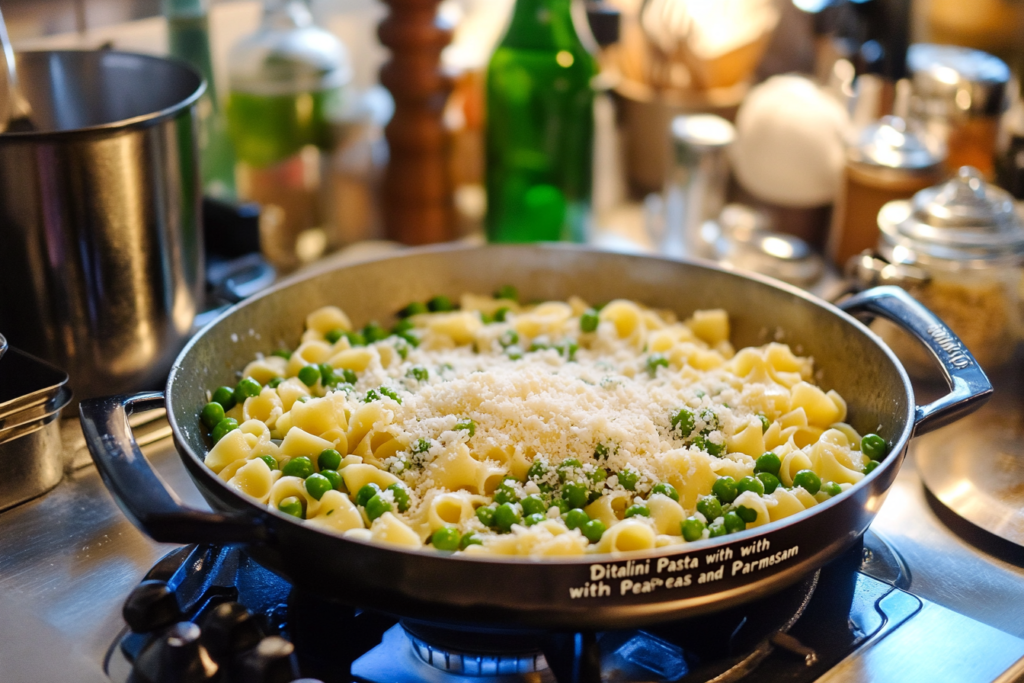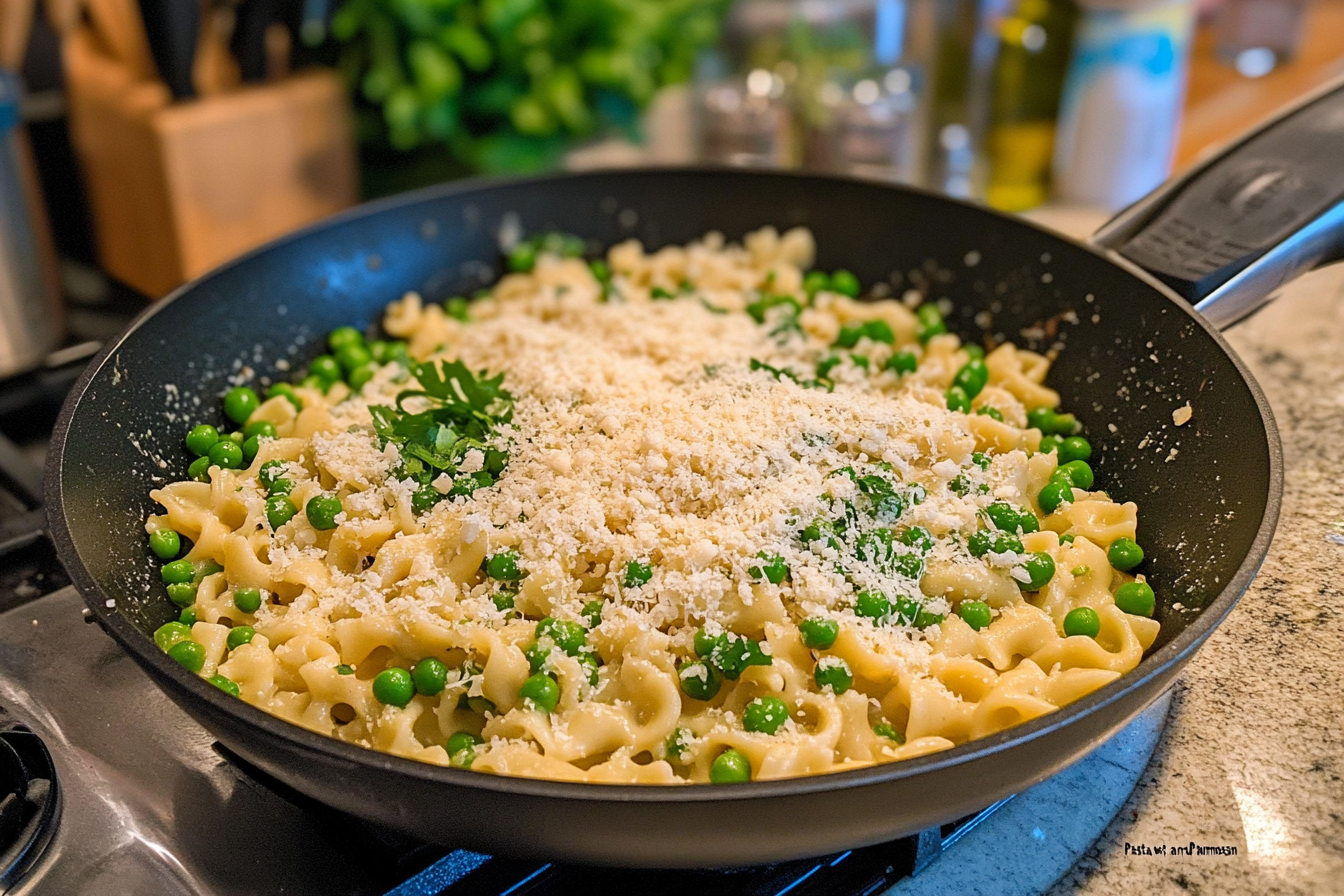Exploring Ditalini Pasta with Peas and Parmesan
Comforting, simple, and brimming with flavor, Ditalini Pasta with Peas and Parmesan is a quintessential Italian dish that has won hearts worldwide. This dish brings together the chewy bite of ditalini pasta, the sweetness of peas, and the creamy richness of Parmesan cheese, creating a perfect harmony of flavors. It’s a versatile recipe that can be whipped up in no time, making it ideal for busy weeknights or casual family dinners.
What sets this dish apart is its adaptability. Whether you’re aiming for a vegetarian meal or adding your own creative twists, Ditalini Pasta with Peas and Parmesan proves that even the simplest ingredients can create something extraordinary.
Historical Background of the Dish
Ditalini pasta has a long and storied history in Italian cuisine. Its name, which translates to “little thimbles,” reflects its small, tube-like shape, making it an ideal choice for soups and stews. Traditionally, ditalini was a staple in peasant cooking, where resourcefulness turned humble ingredients into satisfying meals.
The addition of peas and Parmesan cheese evolved over time as Italian cuisine became more diverse and accessible. Peas, with their natural sweetness and vibrant green hue, added a touch of freshness, while Parmesan contributed its signature nutty flavor and creamy texture. Together, these ingredients created a dish that was not only delicious but also visually appealing—a hallmark of Italian cooking.

Cultural Significance in Italian Cuisine
In Italy, pasta isn’t just food; it’s a way of life. Ditalini pasta dishes like this are deeply ingrained in Italian family traditions, often served during casual gatherings or Sunday lunches. The dish’s simplicity allows it to adapt to regional variations—southern regions might add a touch of spice, while northern areas emphasize creamier textures.
Moreover, pasta with peas and Parmesan exemplifies the Italian philosophy of cooking: using fresh, high-quality ingredients to create meals that are both comforting and satisfying. Its enduring popularity highlights how classic recipes can continue to bring people together around the table, regardless of the occasion.
Ingredients and Their Roles
Every great dish starts with thoughtfully chosen ingredients, and Ditalini Pasta with Peas and Parmesan is no exception. Its beauty lies in its simplicity—each component serves a specific purpose, enhancing both flavor and texture. Here’s a closer look at the key ingredients:
- Ditalini pasta: The small, tube-like pasta is perfect for capturing sauce and providing a chewy bite.
- Peas: Their natural sweetness balances the savory elements, adding pops of color and flavor.
- Parmesan cheese: Nutty, salty, and creamy, Parmesan ties all the ingredients together.
- Olive oil: A drizzle of extra virgin olive oil adds richness and depth.
- Garlic and onions: These aromatics form the flavor base, elevating the dish with their earthy sweetness.
Each of these ingredients plays a role in creating the harmonious flavors that make Ditalini Pasta with Peas and Parmesan so irresistible.
Selecting Quality Ditalini Pasta
The star of the show, ditalini pasta, is prized for its small, hollow shape, which perfectly holds sauces and small ingredients like peas. When selecting ditalini, opt for brands that use high-quality durum wheat semolina. This ensures a firm texture and prevents the pasta from becoming mushy after cooking.
Look for a rough surface on the pasta—this indicates it’s made using traditional bronze dies, which help the sauce cling better. If you can’t find ditalini, other small pasta shapes like orzo or elbow macaroni can be great substitutes, though ditalini remains the classic choice for its unique texture and charm.
The Importance of Fresh or Frozen Peas
Peas bring a delightful sweetness and vibrant green color to the dish. Fresh peas are unbeatable when they’re in season, offering a crisp texture and bright flavor. However, frozen peas are an excellent alternative, as they’re picked and preserved at their peak freshness.
When using frozen peas, thaw them briefly under running water or add them directly to the dish during the final minutes of cooking. Their convenience and consistent quality make them a favorite choice for busy cooks. Either way, peas are an essential ingredient that provides balance and a hint of springtime freshness.
Choosing the Right Parmesan Cheese
Not all Parmesan cheese is created equal. For the most authentic flavor, choose Parmigiano-Reggiano, the “king of cheeses.” This Italian classic is aged for at least 12 months, resulting in a crumbly texture and a deep, nutty flavor.
Grate the cheese freshly at home for maximum aroma and creaminess—pre-grated versions often lack the depth and purity of flavor. While Parmesan is a must, you can experiment with alternatives like Grana Padano or Pecorino Romano if you prefer slightly milder or saltier flavors.
Preparation and Cooking Techniques
Making Ditalini Pasta with Peas and Parmesan is a straightforward process, but getting the perfect balance of flavors and textures requires a little finesse. Follow this step-by-step guide to recreate this comforting dish in your own kitchen.
Step-by-Step Cooking Guide
- Boil the pasta: Bring a large pot of salted water to a rolling boil. Add ditalini pasta and cook until al dente (about 8–10 minutes, depending on the brand). Reserve about half a cup of pasta water before draining.
- Sauté aromatics: Heat a drizzle of olive oil in a large skillet over medium heat. Add minced garlic and diced onions, cooking until fragrant and translucent.
- Add peas: Stir in fresh or frozen peas, cooking until tender and vibrant green.
- Combine and finish: Toss the cooked pasta into the skillet with the aromatics and peas. Stir in freshly grated Parmesan cheese and a splash of reserved pasta water to create a creamy consistency.
- Serve: Garnish with additional Parmesan and a drizzle of olive oil. Enjoy immediately!
Properly Cooking Ditalini Pasta
To achieve the perfect al dente texture, cook the pasta in generously salted water—this is your only chance to season the pasta itself. The salt should mimic seawater in salinity, ensuring the pasta is flavorful on its own.
Check the pasta a minute or two before the package instructions suggest. Ditalini should be tender but still firm to the bite. Overcooking will make it mushy and compromise the dish’s texture. Don’t forget to reserve some pasta water—it’s a game-changer for binding the sauce.
Sautéing Aromatics for Enhanced Flavor
Garlic and onions are the backbone of this dish’s flavor profile, but they need to be treated with care. Heat olive oil in a skillet over medium heat, then add minced garlic and finely diced onions.
Stir frequently to prevent burning, as burned garlic turns bitter. Cooking the onions until they’re translucent softens their bite and enhances their sweetness, which balances the savory Parmesan and the fresh peas. Once the aromatics release their fragrance, you’ll know they’re ready to build the base of your dish.
Combining Ingredients for Optimal Taste
The magic happens when all the ingredients come together. Add the cooked ditalini pasta to the skillet with the peas and aromatics, tossing everything to combine. Slowly incorporate the freshly grated Parmesan cheese, allowing it to melt and coat the pasta.
If the mixture seems dry, add reserved pasta water a tablespoon at a time, stirring until a silky, creamy sauce forms. Be sure to taste and adjust the seasoning with salt and freshly cracked pepper as needed. The result? A perfectly balanced dish that’s creamy, savory, and full of comforting flavors.
Nutritional Information and Health Benefits
Ditalini Pasta with Peas and Parmesan isn’t just a comforting dish; it’s also packed with nutritional value. Balancing carbohydrates, protein, and fats, this meal provides a wholesome combination of energy and essential nutrients. Let’s dive into its nutritional profile to better understand its health benefits.
Nutritional Profile of the Dish
A typical serving of Ditalini Pasta with Peas and Parmesan (around 1.5 cups) provides:
- Calories: Approximately 400–450 kcal, depending on ingredient proportions.
- Carbohydrates: 50–55 grams, primarily from the pasta, serving as a quick energy source.
- Protein: 12–15 grams, contributed by Parmesan cheese and peas.
- Fats: 10–12 grams, primarily healthy fats from olive oil and cheese.
- Fiber: 4–6 grams, mainly from peas and pasta.
This dish is rich in key vitamins like vitamin K, folate, and B vitamins, and minerals such as calcium, iron, and magnesium. With its balance of nutrients, it’s both nourishing and satisfying, making it a great choice for a well-rounded meal.
Health Benefits of Peas
Peas are a nutritional powerhouse, adding both flavor and health benefits to the dish. A cup of peas provides about:
- Protein: 8 grams, making it an excellent plant-based protein source.
- Fiber: 8 grams, supporting digestive health and keeping you full longer.
- Vitamins: High in vitamin C, vitamin A, and vitamin K, peas boost immunity and support bone health.
Their natural sweetness also enhances the dish without adding sugar, making peas a wholesome ingredient that’s as nutritious as it is delicious.
Nutritional Value of Parmesan Cheese
Authentic Parmesan cheese, particularly Parmigiano-Reggiano, offers more than just flavor. It’s an excellent source of:
- Calcium: Aiding in bone strength and density, with a single serving providing up to 30% of the daily recommended intake.
- Protein: High-quality protein to support muscle repair and growth.
- Vitamins and Minerals: Rich in B12, magnesium, and zinc, Parmesan supports energy production and immune health.
While it’s slightly higher in sodium, its intense flavor means you can use less without sacrificing taste. This makes Parmesan a nutrient-dense addition to the dish.
Incorporating Healthy Fats from Olive Oil
Extra virgin olive oil isn’t just a cooking staple; it’s also a health booster. Packed with monounsaturated fats, it helps:
- Heart Health: Reducing bad cholesterol (LDL) and improving good cholesterol (HDL).
- Anti-Inflammatory Benefits: Olive oil contains antioxidants like polyphenols, which combat inflammation and promote overall wellness.
- Vitamin E: This fat-soluble vitamin supports skin health and protects cells from oxidative stress.
Using olive oil as the base for sautéing aromatics adds a layer of flavor while making the dish more nutrient-rich. A drizzle on top before serving not only enhances taste but also delivers additional health benefits.
Variations and Serving Suggestions
Ditalini Pasta with Peas and Parmesan is a dish that invites creativity. Its simplicity serves as a perfect canvas for experimenting with additional flavors and textures. Whether you’re looking to spice things up or accommodate dietary needs, here are some ideas to inspire your next bowl.
Creative Twists on the Classic Recipe
- Pancetta or prosciutto: Add crispy, salty pancetta or prosciutto for a burst of savory flavor.
- Mushrooms: Sautéed mushrooms like cremini or shiitake introduce an earthy depth to the dish.
- Herbs: Fresh basil, parsley, or thyme can elevate the flavor profile, adding brightness and complexity.
- Lemon zest: For a citrusy twist, grate some lemon zest over the pasta before serving.
These additions not only enhance the flavor but also give the dish a more gourmet feel without much effort.
Making It Vegetarian or Vegan
For a vegetarian version, stick to the classic recipe, as it’s naturally meat-free. To make it vegan, consider these substitutions:
- Cheese: Replace Parmesan with a plant-based cheese or nutritional yeast for a cheesy, umami kick.
- Butter: Swap butter (if used) with vegan margarine or additional olive oil.
With these changes, you’ll still achieve a dish that’s creamy, flavorful, and comforting—perfect for everyone at the table.
Pairing with Complementary Side Dishes
Pairing the pasta with the right sides can elevate it into a complete meal:
- Salads: A crisp Caesar salad or arugula tossed with lemon vinaigrette adds a refreshing contrast.
- Breads: Garlic bread or focaccia pairs wonderfully, soaking up the creamy sauce.
- Soups: Light broths like minestrone or vegetable soup complement the richness of the dish.
These sides add variety while ensuring your meal feels balanced and satisfying.
Cooking Tips and Common Mistakes to Avoid
Perfecting Ditalini Pasta with Peas and Parmesan is all about attention to detail. From ingredient preparation to the final mix, a few small adjustments can make all the difference.
Avoiding Overcooking the Pasta
Overcooked pasta is the quickest way to lose the dish’s signature texture. To avoid this:
- Cook ditalini in boiling salted water for 1–2 minutes less than the package instructions for a firm al dente bite.
- Drain promptly and rinse lightly with cold water to halt cooking.
- Toss with a little olive oil if not mixing immediately, preventing it from clumping.
These steps ensure the pasta retains its chewiness, providing the perfect base for creamy sauces.
Balancing Flavors and Seasonings
The balance of salt, pepper, and Parmesan can make or break this dish. To get it right:
- Add salt incrementally, starting with salted pasta water and adjusting after mixing all ingredients.
- Use freshly cracked black pepper for a subtle heat that enhances the dish’s depth.
- Be mindful with Parmesan—its saltiness varies by brand. Start small and taste as you go.
A final drizzle of olive oil or a sprinkle of fresh herbs can tie everything together, giving the dish a polished finish.
Frequently Asked Questions (FAQs)
Even a straightforward recipe like Ditalini Pasta with Peas and Parmesan can spark a variety of questions. Below, we answer some of the most common inquiries to help you make the most of this delicious dish.
Can I use other types of pasta?
Yes, ditalini pasta is the classic choice, but other small pasta shapes work just as well. Consider options like orzo, elbow macaroni, or small shells. These shapes mimic ditalini’s ability to hold sauces and mix seamlessly with small ingredients like peas. While the texture and appearance may vary slightly, the flavors remain just as delightful.
How can I store leftovers?
To store leftovers, transfer the pasta to an airtight container and refrigerate it within two hours of cooking. It will stay fresh for up to three days. When reheating, add a splash of water or broth to restore the creaminess. Heat gently in a skillet or microwave, stirring occasionally to avoid uneven heating.
Is this dish suitable for gluten-free diets?
Absolutely! Substitute regular ditalini with gluten-free pasta made from rice, quinoa, or lentils. These alternatives retain a similar texture and taste while accommodating dietary needs. Be sure to cook gluten-free pasta according to package instructions to avoid overcooking.
What protein additions work well?
Adding protein can turn this dish into a more substantial meal. Popular choices include:
- Grilled chicken: Tender and juicy, it complements the creamy Parmesan.
- Tofu: Pan-fried or baked, tofu provides a vegetarian-friendly protein option.
- Shrimp: Sautéed shrimp adds a seafood twist that pairs beautifully with peas.
How can I make the dish creamier?
For a richer texture, consider these options:
- Stir in a splash of heavy cream or half-and-half during the final mix.
- Add mascarpone or cream cheese for a velvety finish.
- Use more Parmesan cheese and a touch of reserved pasta water to create a silkier sauce.
These additions elevate the dish’s luxurious mouthfeel without overpowering the other flavors.
Can I prepare this dish in advance?
Yes, you can partially prepare the dish ahead of time. Cook the pasta and peas separately, storing them in the fridge for up to two days. When ready to serve, sauté fresh aromatics, warm the pasta and peas, and mix with Parmesan and olive oil. This approach ensures the dish tastes fresh while saving time during busy days.
Embracing the Simplicity and Flavor of Ditalini Pasta with Peas and Parmesan
Few dishes manage to balance simplicity and elegance as well as Ditalini Pasta with Peas and Parmesan. Its combination of creamy Parmesan, tender pasta, and sweet peas creates a comforting meal that’s as satisfying as it is easy to prepare.
Whether you’re trying it for the first time or reinventing it with creative twists, this dish is a testament to the power of simple, fresh ingredients. Gather your ingredients, fire up the stove, and bring a little piece of Italian culinary magic into your home today!


3 thoughts on “How to Make Creamy Ditalini Pasta with Peas and Parmesan”